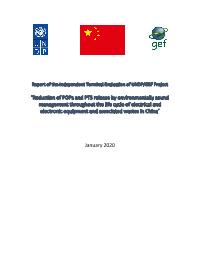
Final Evaluations for Electronic Waste project
Completedon 30 Nov, 2020
Evaluation Plan
Planned End Date
Dec 2020
Evaluation Type
Project
Management Response
Yes
Evaluation Budget
$76,000
Evaluation Title
Final Evaluations for Electronic Waste project
Atlas Project Number
78105
Plan Period
Status
Completed
Type
Project
Plan Date
31 Dec, 2020
Completion Date
30 Nov, 2020
Budget
$76,000
Expenditure
$35,000
Source of Funding
Project budget
Management Response
Yes
Quality Assessment
Yes
Joint Programme
No
Joint Evaluation
Yes
GEF Evaluation
Yes
Expand
Stakeholders
Ministry of Environment
Countries
China
Atlas Project Number
78105
Plan Period
Status
Completed
Type
Project
Management Response
Yes
Plan Date
31 Dec, 2020
Quality Assessment
Yes
Completion Date
30 Nov, 2020
Joint Programme
No
Joint Evaluation
Yes
Budget
$76,000
GEF Evaluation
Yes
Expand
Expenditure
$35,000
Stakeholders
Ministry of Environment
Source of Funding
Project budget
Countries
China
Output 1.4.1 Solutions scaled up for sustainable management of natural resources, including sustainable commodities and green and inclusive value chains
Goal 9. Build resilient infrastructure, promote inclusive and sustainable industrialization and foster innovation
9.4 By 2030, upgrade infrastructure and retrofit industries to make them sustainable, with increased resource-use efficiency and greater adoption of clean and environmentally sound technologies and industrial processes, with all countries taking action in accordance with their respective capabilities
1: Others
2: Sustainable


